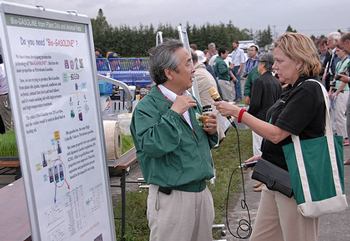 The Philadelphia Eagles don’t just wear green jerseys (although, what was up with those UGLY uniforms this past weekend?). They also are living the green lifestyle.
The Philadelphia Eagles don’t just wear green jerseys (although, what was up with those UGLY uniforms this past weekend?). They also are living the green lifestyle.
This story on the ABC News web site says the team is probably the greenest franchise in American sports:
When the lights come on for an Eagles game at Lincoln Financial Field, 30 percent of the power comes from so-called clean sources, such as wind power and methane reclaimed from landfills.
When the Eagles fly to an away game, their organization plants trees in the Philadelphia area to make up for the carbon dioxide emitted by the team’s plane.
If you go get a beer at halftime, you’ll notice recycling bins every 46 feet on the concourse. Why that distance? Because a study showed people will actually walk that distance to drop off a plastic cup for recycling; any further, and the cups will just be dumped with regular trash.
The team’s tickets are printed on recycled paper. So are the programs. Even the machine that vacuums the field after the game runs on biodiesel.
Gotta love their all-around “Go Green” program and motto.


 The Wisconsin Biodiesel Association is opening its monthly meeting on Wednesday, Sept. 25th at 9:30 a.m. at the Wisconsin DNR office in Madison to the general public.
The Wisconsin Biodiesel Association is opening its monthly meeting on Wednesday, Sept. 25th at 9:30 a.m. at the Wisconsin DNR office in Madison to the general public.
 Students can also learn about the series’ partnership with the ethanol industry through interactive displays and experience what it’s like to drive an IndyCar Series car by testing out an IndyCar Series simulator.
Students can also learn about the series’ partnership with the ethanol industry through interactive displays and experience what it’s like to drive an IndyCar Series car by testing out an IndyCar Series simulator.  With the resignation of US Agriculture Secretary Mike Johanns last week, the
With the resignation of US Agriculture Secretary Mike Johanns last week, the  Johanns was scheduled to be the keynote speaker at the event but now Acting Secretary Chuck Conner will be the keynoter.
Johanns was scheduled to be the keynote speaker at the event but now Acting Secretary Chuck Conner will be the keynoter.  The
The  Back in 2003, the European Union instituted some major reforms in its agricultural sector, which are now known as the “Fischler Reforms” after the Commissioner for Agriculture, Rural Development and Fisheries at the time,
Back in 2003, the European Union instituted some major reforms in its agricultural sector, which are now known as the “Fischler Reforms” after the Commissioner for Agriculture, Rural Development and Fisheries at the time, 
 Researchers at
Researchers at  In a town most famous for peanuts and a president, biodiesel could be the next chapter for Plains, Georgia.
In a town most famous for peanuts and a president, biodiesel could be the next chapter for Plains, Georgia.